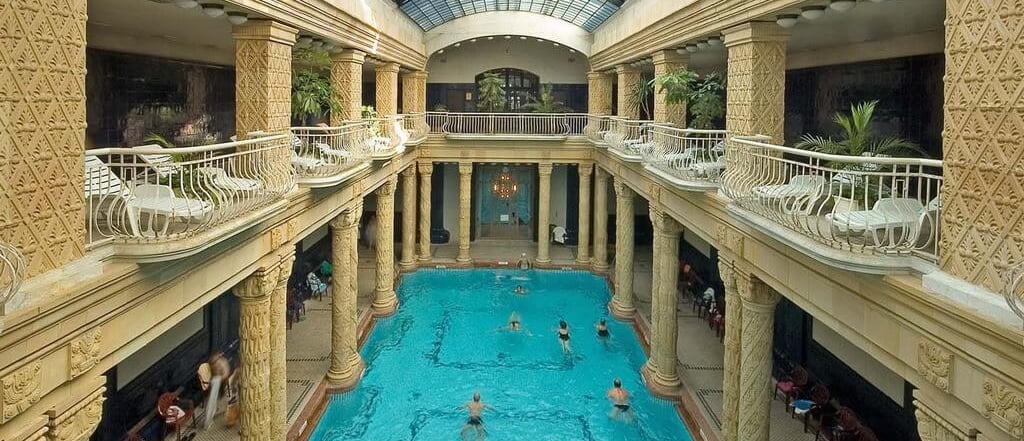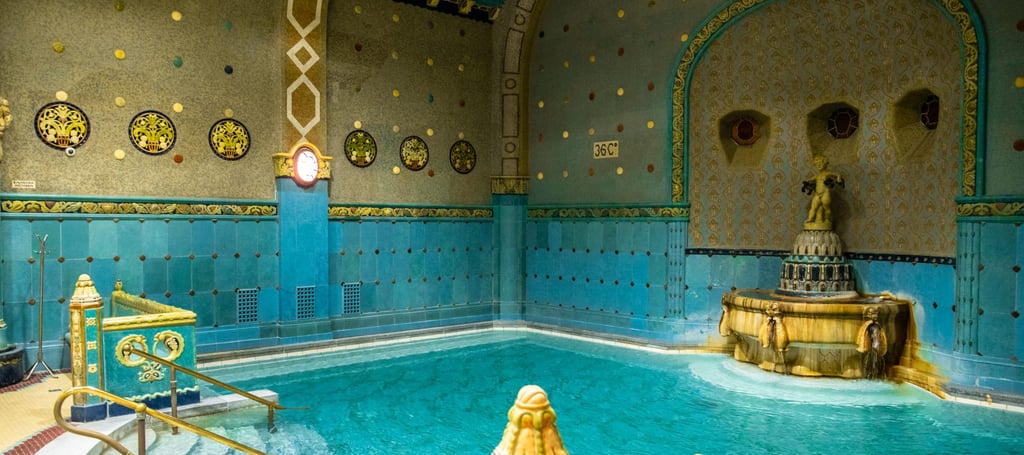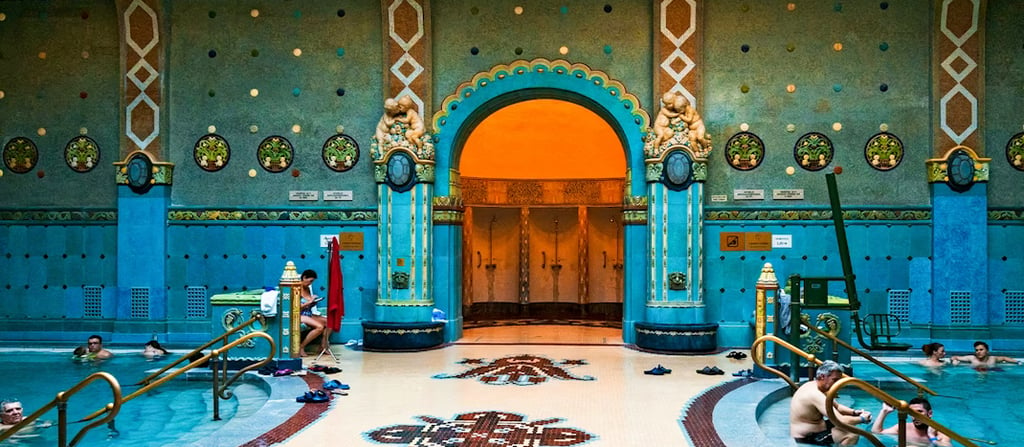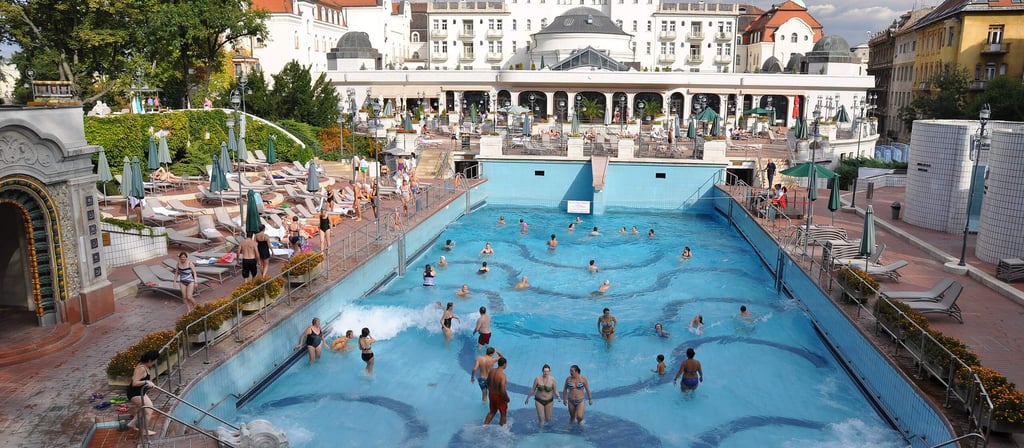Gellért Thermal Bath - Budapest
A breathtaking Art Nouveau masterpiece where healing waters and grand architecture converge beneath stained-glass domes


A Fusion of Architecture, History, and Healing Tradition
The Gellért Thermal Bath stands as a glittering jewel in the crown of Budapest’s thermal culture, seamlessly weaving Art Nouveau grandeur, thermal healing water, architectural restoration, urban elegance, and historical significance into one unforgettable experience. Opened in 1918 as part of the grand Hotel Gellért, the bath was conceived as an embodiment of modern Hungarian hospitality—an opulent sanctuary offering both luxury and wellness. Its ornate entrance opens into a series of mosaic-tiled halls crowned with stained-glass domes, marble columns, and Zsolnay ceramic fountains shaped like mythical beasts. Over the years, wartime damage and political shifts threatened the structure, but a dramatic restoration in the early 2000s returned the bath to its former splendor while updating its infrastructure for modern use. Today, it stands not only as a public spa but as a living monument where spatial artistry and therapeutic ritual converge. Every surface—from carefully restored mosaics to original ironwork and painted friezes—testifies to a time when design and wellness were intertwined in civic pride.
Within its historic walls, the bath’s atmosphere remains vivid and sensual. Soft sunlight filters through stained-glass skylights onto warm, mineral waters. The central thermal pools glisten beneath painted vaults and white marble arches. These early 20th-century design details envelop visitors in an environment that feels both luxurious and timeless. Yet, beneath the aesthetic flourish lies a deeply rooted wellness tradition. The thermal springs that feed the pools carry mineral compositions long sought for therapeutic effect—calcium, magnesium, sulfates, bicarbonate and more—used to treat joint and muscular issues for centuries. Visitors step into a sensory realm where water temperature is meticulously controlled, fountains gurgle softly, and tiled floors guide wandering feet through changing pools, plunge basins, and steam rooms. In that convergence of form and function, the Gellért Bath remains both a healing space and a spectacle of historical design—a place where architecture tells the story of health and elegance.
The Pools, Water Quality, and Bathing Ritual
At the heart of the Gellért Bath lies its collection of pools fed by natural thermal springs flowing at over 70°C. These springs provide mineral-rich water containing sulfates, calcium, magnesium and fluoride, which are believed to support treatment for arthritis, circulatory issues, and spinal ailments. The bath offers a layered bathing experience: deep thermal pools maintained at 35–40°C invite prolonged immersion; the adjacent wave pool, open during summertime, offers mild artificial waves in clear water; an indoor swimming pool maintained at about 27°C allows for gentle laps; and plunge pools with varied temperatures enable contrast therapy. Each pool is framed by mosaic-tiled corridors, underwater windows, and sculpted fountains shaped like fish, cherubs or lotus blossoms, turning movement through them into ritual. For many locals and visitors, bathing at Gellért becomes daily choreography—moving between hot pools, cooling plunge basins, steam, sauna and rest areas. Essential to the ritual is a slow pace: restaurative soaking, quiet cooling breaks, and restorative silence in the central rotunda. This sequence of bathing weaves together sensory immersion, historic choreography, therapeutic layering, and cultural continuity.
The pool spaces are not just practical—they are carefully curated to amplify the experience. Marble benches line edge frames, allowing guests to sit and reflect mid-soak. Enclosed alcoves provide privacy zones for contemplation. Water features add gentle sound and motion. Sunlight through glass domes shifts across tiled surfaces throughout the day. The baths’ acoustics reflect chatter and footsteps softly, lending an echo of urban calm. Visiting parties often stretch into the afternoon, pausing between dips for tea or refreshments served in adjacent cafés. Despite crowds—especially midday and on weekends—the design anticipates movement flow, providing built-in sense of personal space. The combination of therapeutic water, architectural theater, thermal tradition, sensory harmony, and restorative design offers a holistic immersion unmatched in modern bath culture.
Cultural and Urban Context
The location of the bath is integral to its identity: nestled at the foot of Gellért Hill on the Buda side of the Danube, it shares the square with Hotel Gellért and adjoins Liberty Bridge, connecting Buda and Pest. The bath’s copper rooftops and mosaic towers dominate views from the quay and the riverbank, especially as dusk falls. It is part of Budapest’s network of historic thermal baths—along with Széchenyi, Rudas, and Lukács—each contributing a facet of spa legacy. Yet Gellért stands apart for its architectural drama and wellness theatre. The bath frequently features in films, photo shoots, and tourist itineraries. In winter, steam rising from outdoor pools against snow-dusted stone adds cinematic allure. It hosts cultural events like night baths accompanied by live music, raising an atmosphere of mythic indulgence. This public institution has become part of Budapest’s urban identity—worshipping both healing ritual and architectural elegance. It offers visitors not just wellness but cultural immersion: stepping into national heritage, from Turkish thermal legacy to Austro-Hungarian design ambition.
Modern Wellness Extensions: Treatments, Saunas, and Restoration Suites
In addition to public bathing, Gellért provides optional medical and wellness treatments. Private massage suites offer mud wraps, aroma therapy, and classic massages using local therapeutic oils. Physiotherapy procedures such as electrotherapy, underwater traction, and peaty mud treatments are available by request, often prescribed by Hungarian medical spas. The complex also includes sauna rooms, steam cabins, and plunge pools for contrast therapy. Treatments are delivered in discreet booths decorated with mosaic tile and soft lighting, offering privacy within a public framework. Whether booking a quick 20-minute massage or a full hour of focused therapy, guests experience personal therapeutic care, thermal medicine, spa supplementation, sensory retreat, and cultural wellness heritage. Specialized spa packages may include guided sessions or traditional Hungarian cooling traditions like beer bathing. These services complement the thermal soak sequence, enriching the experience for those seeking health restoration as well as architectural beauty.
Practical Information
Gellért Thermal Bath is located at Szent Gellért tér 1, 1118 Budapest, on the Buda side directly adjacent to Liberty Bridge. The baths are open daily from approximately 9:00 AM to 7:00 PM, with last admission mid-afternoon. Entry fees vary by season and day of the week, with higher rates on weekends. Towels, swimsuits, and swim caps can be brought or rented onsite. Changing rooms, showers, and lockers are provided; a key deposit system is in place. Public transport access includes tram and metro stops at Szent Gellért tér and bus lines nearby. The spa is accessible for guests with reduced mobility. Peak times include midday hours on weekends; early morning or late afternoon visits are quieter. Smoking is prohibited inside. Appropriate swimwear is required in all pools. Health treatments and massages must be booked in advance at the service desk. Outdoor wave pool operates seasonally from late spring through early autumn. Towels and slippers may be required in certain pools. Visitors may enjoy full-day bathing, and some medical procedures may require certification.
Official Links
For ticket information, spa treatments, opening hours, and visitor policies, visit:
https://www.gellertbath.hu/
Follow on social media for updates and visuals:
Instagram: GellertBathBudapest
Facebook: Gellért Thermal Bath Budapest


Restoration, Artistic Detail, and Architectural Highlights
The bath’s restoration has been more than functional—it has been deeply artistic. Craftsmen painstakingly restored ceilings, columns and mosaic medallions originally installed over a century ago. Tiles were recreated using traditional techniques, stained-glass windows styled in floral and geometric motifs were repaired or reconstructed using historic templates, and wrought-iron railings were cleaned and reinforced. Many original statues—dwarves, mermaids, and lion heads—were preserved, while new fixtures were crafted to match. Inside the building, corridors remain lined with period lighting, painted ceilings and decorative friezes depicting mythic scenes and floral patterns. The decorative programm includes Hungarian folk symbols like tulip and bird motifs woven into panel work and mosaic detail. Restoration architects focused on balancing authenticity with updated infrastructure: pool pipes, heating, ventilation and accessibility improvements were integrated invisibly, ensuring both safety and historical integrity. The restoration work exemplifies craftsmanship revival, design authenticity, heritage reconstruction, and a philosophy that spa architecture can be both beautiful and therapeutic.
Visitors often pause to observe details at eye level: mosaic insets of peacocks, sculpted capitals of columns, glass lanterns shaped like inverted acorns. Even changing rooms reflect artistic care—grouted tile benches, marble sink vanities, and decorative ceramic reliefs. Outdoor terraces, once used for sunrest, were repaved in patterned stone. The bathing hall opens through archways to a courtyard with fountains, providing outdoor relaxation under the summer sky. All these design gestures communicate a reverence for aesthetic tradition—a belief that public wellness deserves architectural poetry. Whether viewed under morning sun or twilight lamps, the bath remains breathtaking. Each surface, corner, and visual plane invites discovering a layer of history. This holistic restoration ensures that bathing here is not only routine but also a pilgrimage of form and memory.
The Visitor Experience: Atmosphere and Flow Memoir
Walking into Gellért Bath is entering a sequence of spaces curated for transition, reflection, quiet conversation, and release. Visitors begin at the ticket hall, change into swimsuits and slippers, receive a locker key, then descend toward the central hall. The first glimpses of breathtaking arches, the vaulted ceiling, and the shimmering pools evoke awe. Guests drift from hot water immersion to sitting benches, stepping into plunge pools at cooler temperatures, visiting steam rooms or swim lanes, and pausing in lounge corridors. The bath is busiest midday—families racing toward wave pools in summer, elders visiting for therapeutic dips, tourists photographing mosaic detail—and quieter in the morning or evening. A full experience might involve two hours of ritual: entering the pool at 38°C, resting on marble bench, stepping into a cold plunge, lingering in the wave pool, and finally heading above to enjoy a herbal tea in the adjacent atrium café.
Despite the crowds, the feeling of spaciousness and calm is sustained by period architecture and high ceilings: sounds carry softly but do not overwhelm. Seasonal practices—such as midday light refracting through glass—alter the mood with gentle natural rhythm. The all-male and all-female changing areas are generous and well-maintained; mixed bathing is possible in most pools. On weekends, small kiosks offer lotions, thermal water bottles, or snacks, making the bath feel alive yet self-sufficient. Bathing etiquette is observed: robes at pool edges, respectful quiet in deeper pools, swim caps in swim lanes, and deposit-token systems for locker keys. Local visitors may come in specialized robes over street clothes, while foreign guests often rent towels and swimsuits onsite. In either case, the bath’s atmosphere merges privacy with public ritual—a communal experience anchored in personal restoration.






Gellért Thermal Bath received the Excellence Award for its exceptional union of architectural splendor, historic restoration, thermal healing tradition, and urban cultural identity. It is worth the trip not just for its exquisite pools and design, but for offering a centuries-old wellness experience in a setting that feels poetic, refined, and deeply embedded in Budapest’s soul.






